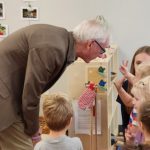Walker’s attack on the arts could stunt economic growth
The arts are important. There I said it, and even though this story concerns Scott Walker’s biennial budget proposal, I’ll say it again: the arts are important.
There have been numerous studies supporting the hypothesis that children who pursue band, theater or other artistic endeavors score higher than their counterparts on standardized tests. Music students do better at math (it must be all that counting rests) and the creativity nurtured through the exposure to arts helps in many areas of academia.
Walker even told me he supported the arts early in his campaign for governor.
But now, Walker is proposing to move the Wisconsin Arts Board under the oversight of the Board of Tourism and cut its funding by 73 percent. In real dollars, that is a drop from $3 million in state funding to only $750,000. Staffing cuts will reduce WAB personnel from 10 to 4. He said moving the Arts Board to Tourism will help focus support for the arts and grow the economy.
Currently Wisconsin’s funding of the arts 38th in the nation and cuts of this magnitude will drop us lower still.
“If we are seeking in America, let it be for the reality of democracy in the arts. Let art begin at home and let it spread through the children and the parents, and through the schools and the institutions, and through government. And let us start by acceptance, not negation; acceptance that the arts are important everywhere, and that they can exist and flourish in small places as well as large, with money or without it, according to the will of the people. Let us put firmly and permanently aside the cliché that the arts are a frill. Let us accept the goodness of art where we are now, and expand its worth in the places where people live.”
WAB President Barbara Lawton acknowledged the partnership the Arts Board and Department of Tourism have enjoyed over the past 38 years, but explained each agency has a unique mission and focus.

Milwaukee Symphony Orchestra educational outreach. Photo provided by the MSO
“Each agency is focused on its unique mission but lending expertise and leveraging strength for the other,” Lawton said. “Our work is not redundant. Wisconsin, now more than ever, needs a state agency specifically focused on the arts and the cultural infrastructure of its communities large and small, an agency that also provides a point of investment for that infrastructure. The state actually needs to invest in the arts to ensure the context and conditions that will make our economy robust and prosperous.”
At issue is the idea of the Arts Board, which supports and develops art communities and activities versus Tourism, which markets activities. Without an independent Arts Board, there are fears that arts education and creative development will end up on the sidelines.
Anne Katz, executive director of Arts Wisconsin, said that at particular risk from the proposed cuts are arts education programs in schools and consulting services to entrepreneurial artists. The WAB also oversees the Percent for Art program, which encourages public art installations throughout the state. She added that the cuts seem counter-productive to developing a vibrant arts economy in Wisconsin.
“This proposal says Wisconsin is closed for business,” Katz said. “Involvement with arts provides skilled workers needed to create jobs.”
In a study completed by the Arts Board in 2005, Wisconsin’s non-profit arts organizations and their audiences generated over $418 million in economic activity and created more than 15,000 full-time equivalent jobs. In the mostly rural, northwestern quadrant of the state, the direct economic impact of artists and craftspeople was more than $32 million.
In larger terms, the creative economy including the arts and design, is one of the fastest growing in the world, with a 14 percent growth rate. In Wisconsin alone, arts and creative industries represent at least 3.6 percent of the total employment.
Katz said the board and Arts Wisconsin will be working to reduce the cuts to a more equitable 10 percent. She also asked that voters contact members of the Joint Finance Committee and their representatives to urge them to restore the agency to independent status.
In the Milwaukee-area, WAB provides grants to many arts groups, from the Milwaukee Symphony Orchestra, Peck School of the Arts and the Skylight Opera, to some of the smallest, including African American Children’s Theater and the Riverwest Artists Association. The awards range from a few thousand dollars to $40,000 per grant.

Public art funded by the Percent for Art program outside the Lee Sherman Dreyfus State Office Building in Waukesha. Photo courtesy Wisconsin Arts Board.
“This money is used for outreach and access in the community,” Katz said about the Milwaukee grants. “People are being exposed to the arts through these funds. We provide technical assistance for arts festivals and help small artists grow their businesses.”
It is those entrepreneurial artists that Katz worries about, since they are working artists who are trying to make a living and contribute to the economy.
Growing the economy and attracting businesses to Wisconsin is exactly why the arts are important, according to Jonathan Jackson, Artistic and Executive Director at Milwaukee Film. While not a recipient of WAB funds (the organization hasn’t been in existence long enough to qualify), Jackson sees the benefit.
He said many of the corporate sponsors of the Milwaukee Film Festival see the arts as a factor to attracting and retaining skilled, vibrant workers within the community. In Eau Claire, high tech companies Genesis 10 and RAI Stone Group located in the community because their owners were confident they could attract the workforce needed based on the city’s cultural offerings.
“Arts are our soul, a lifeblood that brings together society,” Jackson said. “If a community doesn’t have a cultural life, who would want to live in that kind of world?”
For more information about the Wisconsin Arts Board and their efforts to slow Gov. Walker’s proposed cuts, click here.























Mr.Abele is a big supporter of the arts. How does he feel about this? While the Percent for Art program has brought us some great art, those examples are few and far between.
also, on the front page of this article, whose work is that? Simon Sparrow? Help me.
The picture attached to this story on the TCD Home page is a mural created by students enrolled in the Milwaukee Public Schools. – Patti
The Wisconsin arts community’s worst problem: CONSTANT pettiness, sniping and disparagement over which artists and projects are “great” enough to deserve attention, unfailingly expressed in snarky hyperbole. No wonder the arts are such an easy target for the enemies of thought.
The arts are indeed important and arts education does indeed improve students performance across the board. And yes we do need to have an independent Arts Board as well as community support for the arts. Unfortunately, the arts can be an easy target for disparagement because controversial projects get a lot of media attention – controversy is like blood in the water for the sharks in the media. But the vast majority of arts programs and practices are not controversial. Cutting support for the arts because some projects have detractors is like cutting support for medicine because of the malpractice of a few doctors.
thanks Patti. The MPS art kid did a great job on their mural.
Without arts funding in schools I may never have known that I was a poet/writer/journalist/visual artist. Instead I found out early on and here I am today, still living a life of creativity!
Thank you, Patti. This article is a simple but hopefully important contribution to our state’s future.
I am reminded of our great former lt. governor, Barbara Lawton, and the constructive work she did supporting the arts, in our schools and communities. She understands the importance of the arts and culture to our existence.
Yes, we have a financial problem, no question, and we must effect a combination of revenue increases and spending decreases – but we must not destroy our society to save it!
He doesn’t care. Nothing he does is about the good of the state. It’s all about grandstanding for his yahoo audience and sucking up to the lunatics and cynics who own the Publican party. He wants to be on Fox when he grows up.